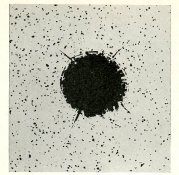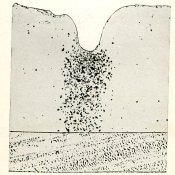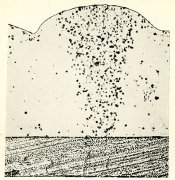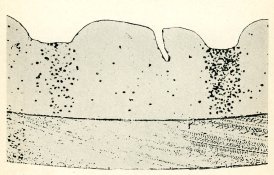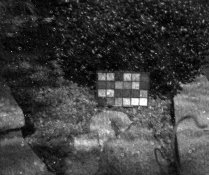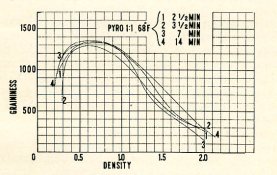Photo Engineer
Subscriber
I have been struck by the many comments here and elsewhere about grain clumping. I have been searching my library and other resources on this topic, and find no authoritative sources that say it takes place but several that say it does not, and they offer proof.
The closest I can come to a literature reference is this paraphrase, which I believe is from one of the works by Ross, to be cited below. Basically, he contends that some people claim to have seen clumps when viewing a film but what they are really seeing are the inevitable statistical patterns we see when we look at thousands upon thousands of grains stacked vertically. When we look at a cross section, they are separated into distinct grains. The first photo below is an example of looking down through a black dot on a film. You can see an indistinct edge made up of what appear to be clumps. Well, I'll get into that later on here.
F. E. Ross, a scientist working at Kodak in the 20s was tasked to find out several things that related to astrophotography. Basically, the astronomers wanted to know if silver metal particles could move horizontally in film as they had observed some movement due to the Kostinsy effect in spectrograms.
Kostinsky effect
The development effect in which dense image points are inclined to move apart, relative to each other, and light image points to move together, relative to each other. This occurs because developer is not being equally distributed over the image point and is rapidly exhausted when to heavily exposed image points are close together.
http://www.swpp.co.uk/glossary/kostinsky_effect.htm
http://books.google.com/books?id=WX...kQ6AEwAQ#v=onepage&q=kostinsky effect&f=false
Ross has written several papers and books on the subject of the movement of silver metal images and particles in gelatin and shows that silver metal just does not move very far. He has studied tanning developers and ordinary developers over a pH range that would satisfy most of us and he did his work on glass plates to insure that the dimensional stability of films of that era was not interfering.
This was summarized in the book above and in his article "Film distortion and accuracy of photographic registration of position." I've attached photos below.
Photo #1, looking down at a small circular exposure showing what appear to be clumps around the edges (see comments above)
Photo #2, cross section of the same exposure using a tanning developer and showing the tanning effect in lower gelatin layer thickness.
Photo #3, cross section of the same exposure using a non-tanning developer. The gelatin has expanded in this case.
Photo #4, cross section showing two identical exposures processed in a tanning developer
Using this type of measurement, Ross was able to show that the images or parts thereof moved less than 2 microns from the original site of exposure. There was no evidence of clumping.
In Photo #5, I have produced an aggregated emulsion by using a low level of gelatin. Now, you may call this clumping as well. You can do this in 2 ways. You use too little gelatin for conditions when you make an emulsion or you use too little gelatin when coating an emulsion. Either way, grains coalesce and "clump" or "aggregate" and you get pepper grain. You see, when a grain touches another grain before or during development and forms a larger "lump", you get fog which is what you see in this print. This is how clumping appears in a print. White dots are seen. They can be virtually any size from the equivalent of several grains up to thousands of grains of Silver Halide.
I would like to thank those who helped me in off-line exchanges on this topic. In particular, I would like to thank AgX for his mention of Kostinsky. And for his permission to use this from our off-line discussion. In the articles I have, Ross does not mention Kostinsky.
PE
The closest I can come to a literature reference is this paraphrase, which I believe is from one of the works by Ross, to be cited below. Basically, he contends that some people claim to have seen clumps when viewing a film but what they are really seeing are the inevitable statistical patterns we see when we look at thousands upon thousands of grains stacked vertically. When we look at a cross section, they are separated into distinct grains. The first photo below is an example of looking down through a black dot on a film. You can see an indistinct edge made up of what appear to be clumps. Well, I'll get into that later on here.
F. E. Ross, a scientist working at Kodak in the 20s was tasked to find out several things that related to astrophotography. Basically, the astronomers wanted to know if silver metal particles could move horizontally in film as they had observed some movement due to the Kostinsy effect in spectrograms.
Kostinsky effect
The development effect in which dense image points are inclined to move apart, relative to each other, and light image points to move together, relative to each other. This occurs because developer is not being equally distributed over the image point and is rapidly exhausted when to heavily exposed image points are close together.
http://www.swpp.co.uk/glossary/kostinsky_effect.htm
http://books.google.com/books?id=WX...kQ6AEwAQ#v=onepage&q=kostinsky effect&f=false
Ross has written several papers and books on the subject of the movement of silver metal images and particles in gelatin and shows that silver metal just does not move very far. He has studied tanning developers and ordinary developers over a pH range that would satisfy most of us and he did his work on glass plates to insure that the dimensional stability of films of that era was not interfering.
This was summarized in the book above and in his article "Film distortion and accuracy of photographic registration of position." I've attached photos below.
Photo #1, looking down at a small circular exposure showing what appear to be clumps around the edges (see comments above)
Photo #2, cross section of the same exposure using a tanning developer and showing the tanning effect in lower gelatin layer thickness.
Photo #3, cross section of the same exposure using a non-tanning developer. The gelatin has expanded in this case.
Photo #4, cross section showing two identical exposures processed in a tanning developer
Using this type of measurement, Ross was able to show that the images or parts thereof moved less than 2 microns from the original site of exposure. There was no evidence of clumping.
In Photo #5, I have produced an aggregated emulsion by using a low level of gelatin. Now, you may call this clumping as well. You can do this in 2 ways. You use too little gelatin for conditions when you make an emulsion or you use too little gelatin when coating an emulsion. Either way, grains coalesce and "clump" or "aggregate" and you get pepper grain. You see, when a grain touches another grain before or during development and forms a larger "lump", you get fog which is what you see in this print. This is how clumping appears in a print. White dots are seen. They can be virtually any size from the equivalent of several grains up to thousands of grains of Silver Halide.
I would like to thank those who helped me in off-line exchanges on this topic. In particular, I would like to thank AgX for his mention of Kostinsky. And for his permission to use this from our off-line discussion. In the articles I have, Ross does not mention Kostinsky.
PE








